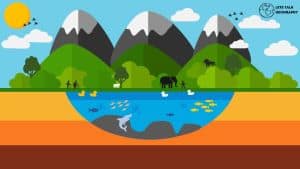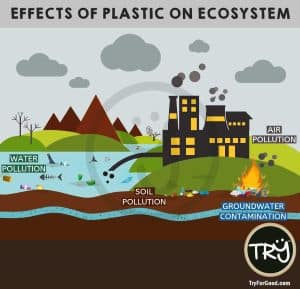The living things in an ecosystem are known as biotic factors. Biotic factors include the plant and animal life of a region.

Some amazing facts about ecosystems:
- An ecosystem and its types are determined by geography.
- Animals and plants within an ecosystem depend on each other for their survival. If conditions change, the animals and plants have to adapt.
- Sometime ecosystems change because of a climate change or a natural disaster. Sometimes, ecosystems are destroyed by humans.
Table of Contents
- A community of living organisms and their nonliving environment
- All living and non-living substances present in a particular place are a(n)
- Any chemical, physical, or biological change in the environment that harms living organisms is
- Community and its nonliving surroundings
- Describe living factors in the environment
- Ecosystem examples of living things
- Ecosystem non examples
- Nature works ecosystem
- Non examples of ecology
- What components of an ecosystem are not part of a community?
- What is a living thing that is not normally found in the ecosystem called?
- What is not an ecological role of plants?
- Which of these are the living organisms in an ecosystem?
A community of living organisms and their nonliving environment
A community of living organisms and their nonliving environment is an ecosystem. Different species of animals live in different types of environments.
The physical location where an organism lives is termed its habitat.
There are mainly two types of habitats: terrestrial, or land, habitats and aquatic, or water, habitats.
Organisms and their nonliving environment are connected

Organisms and their nonliving environment are connected because living beings need nonliving things to survive.
Without food, water, and air, living things die. Sunlight, shelter, and soil are also important for living organisms. Living things meet their needs by living alongside non-living things in ecosystems.
All living and non-living substances present in a particular place are a(n)
All living and non-living substances present in a particular place are a part of their ecosystem. An ecosystem is a location on Earth that includes living substances called biotic factors, and non-living substances called “abiotic factors.”
Environmental differences within ecosystems are generally caused by abiotic factors.
All living organisms in an environment
All living organisms in an environment that interact with each other for their survival make up an ecosystem.
An Ecosystem Needs Plants as the Primary Food Source as they convert solar energy to food by photosynthesis.
Any chemical, physical, or biological change in the environment that harms living organisms is

Any chemical, physical, or biological change in the environment that harms living organisms is called pollution.
Nature discourages waste by employing one organism to feed on the waste products of another. It is only when we interfere with nature and reduce its biodiversity that waste becomes evident. Eco-logic suggests that unpleasant natural mechanisms are nature’s way of warning us about wasted resources.
Community and its nonliving surroundings
The community and its nonliving surroundings make up an ecosystem.
A collection of several interacting populations that inhabit a common environment is called a “community,” while the non-living environment consists of abiotic factors such as sunlight, soil, etc.
Abiotic factors include non-living resources and physical conditions that impact living components in the terms of reproduction, maintenance, and growth.
Resources are differentiated as objects and substances in an environment needed by a single organism and exhausted or otherwise created unavailable to use by various other organisms.
Component deterioration of a substance appears by physical or chemical processes such as hydrolysis. Every non-living component of the ecosystem like water resources and atmospheric conditions are known as ‘Abiotic components’.
Describe living factors in the environment
The living factors in the environment are known as biotic factors. Biotic factors include plants, animals, and micro-organisms.
Biotic components can be classified into three categories:
Producers: These include all the autotrophs. They use light energy and synthesize food on their own, e.g. plants, green algae, etc.

Consumers: These include all the heterotrophs that directly or indirectly depend on producers for their food. Consumers are further categorized as herbivores, carnivores, omnivores, and parasites.
Decomposers: These include saprophytes, which act on dead matter and decay it for their own nutrition.
The relevance of biotic and abiotic components in an environment appears when they start interacting with each other. For example, biotic elements like plants provide food for other organisms. The soil is the abiotic element which supports the growth of the plants by providing nutrients and other essential elements. Biotic components depend on abiotic components for their survival and help in the formation of abiotic factors like soil, nutrients, etc.
Ecosystem examples of living things
Ecosystem examples of living things are organisms such as plants, animals, fungi, and bacteria. Living things grow, change, produce waste, reproduce, and dieOrganisms interact with the living things and the non-living environment in their ecosystem to survive. A forest is a type of ecosystem.
Living things in an ecosystem
The living things in an ecosystem are producers, consumers, and decomposers. They are all important parts of an ecosystem. The producers are the green plants. They make their own food.
What lives in an ecosystem?
Animals, plants and bacteria live in an ecosystem. Ecosystems are large, and the area where an organism lives is called it’s habitat.
The living parts of an ecosystem are called biotic factors while the environmental factors that they interact with are called abiotic factors.
Biotic factors such as the presence of autotrophs or self-nourishing organisms such as plants, and the diversity of consumers also affect an entire ecosystem. Abiotic factors affect the ability of organisms to survive and reproduce. Abiotic limiting factors restrict the growth of populations.
Ecosystem non examples
Ecosystem non examples are stars, molten lava in a volcanic caldera, the inside of a nuclear reactor, etc.
New ecosystems were discovered recently deep in the Southern Ocean near Antarctica. Scientists have discovered 23 new animal species living in the hot, dark environment around hydrothermal vents.Organism survival here is a result of environmental evolution.
Nature works ecosystem
Nature works in an extremely delicate pattern, as the 4 laws of ecology suggest
- Everything is connected to everything else.
- Everything must go somewhere.
- Nature knows best.
- There’s no such thing as a free meal.
Non examples of ecology
Non examples of ecology are when speciation is not driven by (or strongly correlated with) divergent natural selection. It is likely that many instances of non ecological speciation are allopatric, especially when the organisms in question are poor dispersers (e.g., land snails, salamanders).
What components of an ecosystem are not part of a community?
Components of an ecosystem that are not part of a community are abiotic components.
Abiotic components contain soil, acidity, atmosphere, humidity, temperature, radiation, light, and water in biology. Often, the macroscopic climate affects all of the above. The sound and pressure waves might be considered in the terms of sub-terrestrial or marine environments
What is a living thing that is not normally found in the ecosystem called?
A living thing that is not normally found in the ecosystem is an invasive species.They upset the natural balance.
In nature, an ecosystem is balanced with predator-prey relationships that keep populations from getting too high.
When invasive species are introduced, three possible things can happen to existing animals.
- The animals can adapt and stay in that ecosystem.
- The existing animals die or
- The animals can move somewhere else to find a new home.
What is not an ecological role of plants?
Occupying the top levels of the food web is not an ecological role of plants.
Generally, the animals in an ecosystem occupy the top levels of the food web as they unlike plants who create their own food through photosynthesis, depend on other plants or animals for their nutrition.
Which of these are the living organisms in an ecosystem?
The living organisms in an ecosystem are producers, consumers, and decomposers. An organism’s environment consists of Biotic and abiotic factors
Which term refers to all areas of earth where life exists?
The term that refers to all areas of the earth where life exists is the biosphere. The biosphere includes all organisms and the part of earth where they exist.